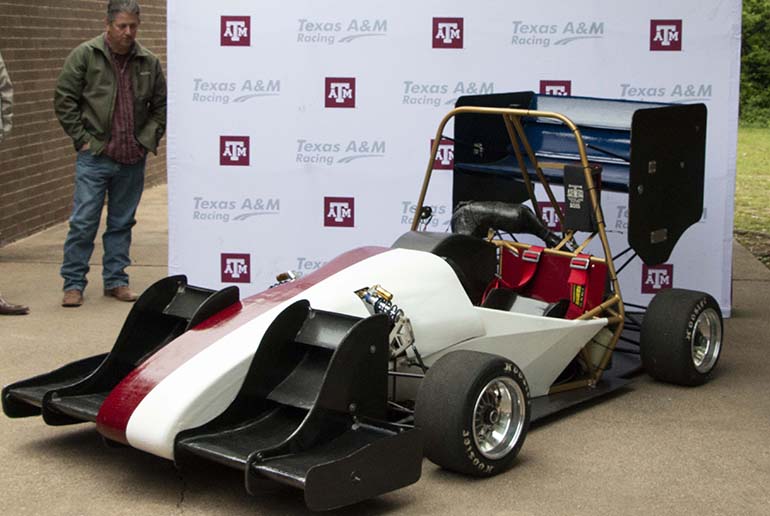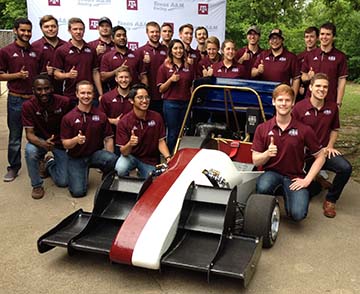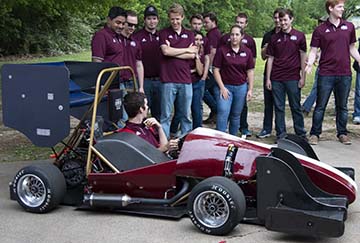
Texas A&M’s Formula SAE team is about a month from international competition, and the 22 members are revving their engines.
Since August 2017, the team has been discussing, designing, building and testing a race car they created from scratch. Along with racing the car, the students are judged on design, cost of manufacturing, their presentation of a business model and other vehicle components.
On top of building a car from scratch, all the students graduated in May. Some will pursue master’s degrees while others already have jobs lined up in the automotive and other industries.
For many of the members, their interest in the program was piqued when they first started at Texas A&M, although their interest in cars may have started long before.
“Growing up I bonded with my family by working on cars, so then coming into college I wanted to study mechanical engineering so I could work on cars, and this was the perfect opportunity to make a childhood dream come true,” said project manager Spencer Weaver.
Over the past two semesters, Adam Isaacks said he has been impressed by the work ethic of the group.
“It’s pretty common that whenever you’re put into a group where there’s a project there’s always going to be that one person who doesn’t carry their weight,” he said. “But somehow on a team of 22 members there’s not a single person who doesn’t carry their weight, and I think that’s going to help us be successful.”
 Unlike other university teams, Texas A&M’s team also doesn’t pass along designs year to year. Instead, they bring in a fresh approach to the design and data.
Unlike other university teams, Texas A&M’s team also doesn’t pass along designs year to year. Instead, they bring in a fresh approach to the design and data.
“We do a full redesign every year while others will take the old design and tweak it,” said team member Zach Beck. “We make a new car from scratch every year.”
There are a number of rules the students follow within the dimensions of a Formula car so that the car remains safe for drivers. This year’s team added another challenge by redesigning the car’s chassis, or frame, which has been similar in the past several years.
“We’re taking a whole new approach to it, and the biggest challenge is figuring out does it fit into the rules, can we actually build this and how will we package everything around this new design,” Weaver said.
 The car is test drove on a concrete runway at the RELLIS campus, but even with the practice, Weaver said the track will be different at competition making it hard to predict how the car will handle.
The car is test drove on a concrete runway at the RELLIS campus, but even with the practice, Weaver said the track will be different at competition making it hard to predict how the car will handle.
Sarah Rohmer, team lead of the electrical subgroup, crew chief and a purchasing manager for the team, said she has appreciated the hands-on experience with automotive she has gained through the project.
“I’ve seen firsthand how designs get implemented and problems that can happen,” she said. “When you look at a drawing on a computer, it’s really hard to see and visualize all the problems that might arise but when you’re working on the car you see, ‘Ooh a wrench can’t fit in there, that isn’t the best design.’ You see a lot more complications.”
The team will head to Lincoln, Nebraska, in mid-June for the SAE International competition June 19-23, where they will face 80 teams from schools across the country and world.
“Growing up I bonded with my family by working on cars, so then coming into college I wanted to study mechanical engineering so I could work on cars, and this was the perfect opportunity to make a childhood dream come true,” said project manager Spencer Weaver.
Over the past two semesters, Adam Isaacks said he has been impressed by the work ethic of the group.
“It’s pretty common that whenever you’re put into a group where there’s a project there’s always going to be that one person who doesn’t carry their weight,” he said. “But somehow on a team of 22 members there’s not a single person who doesn’t carry their weight, and I think that’s going to help us be successful.”
 Unlike other university teams, Texas A&M’s team also doesn’t pass along designs year to year. Instead, they bring in a fresh approach to the design and data.
Unlike other university teams, Texas A&M’s team also doesn’t pass along designs year to year. Instead, they bring in a fresh approach to the design and data.“We do a full redesign every year while others will take the old design and tweak it,” said team member Zach Beck. “We make a new car from scratch every year.”
There are a number of rules the students follow within the dimensions of a Formula car so that the car remains safe for drivers. This year’s team added another challenge by redesigning the car’s chassis, or frame, which has been similar in the past several years.
“We’re taking a whole new approach to it, and the biggest challenge is figuring out does it fit into the rules, can we actually build this and how will we package everything around this new design,” Weaver said.
 The car is test drove on a concrete runway at the RELLIS campus, but even with the practice, Weaver said the track will be different at competition making it hard to predict how the car will handle.
The car is test drove on a concrete runway at the RELLIS campus, but even with the practice, Weaver said the track will be different at competition making it hard to predict how the car will handle.Sarah Rohmer, team lead of the electrical subgroup, crew chief and a purchasing manager for the team, said she has appreciated the hands-on experience with automotive she has gained through the project.
“I’ve seen firsthand how designs get implemented and problems that can happen,” she said. “When you look at a drawing on a computer, it’s really hard to see and visualize all the problems that might arise but when you’re working on the car you see, ‘Ooh a wrench can’t fit in there, that isn’t the best design.’ You see a lot more complications.”
The team will head to Lincoln, Nebraska, in mid-June for the SAE International competition June 19-23, where they will face 80 teams from schools across the country and world.